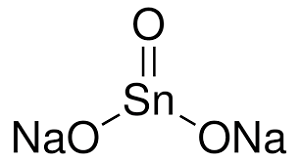Sodium Stannate

Product Description
Sodium stannate, an inorganic compound with the chemical formula Na2SnO3, finds various industrial applications due to its unique properties.
Product:
Sodium Stannate
CAS:
12058-66-1
Synonym:
Sodium tin oxide; Disodium tin trioxide
Structure:

Typical Characteristics
Appearance
White to off-white powder
Density
4.68 g/cm3
Melting point
140 °C
Molecular Weight
212.69
Odor
Odorless
Purity
99%
Uses, Applications & Markets
Key applications
Markets
get a quote
We Offer Sodium Stannate
in various grades
A few of the grades available are listed below:



Sodium Stannate used in many
industry applications
Sodium stannate, an inorganic compound with the chemical formula Na2SnO3, finds various industrial applications due to its unique properties. Here are some of its key industrial uses:
- Electroplating: Sodium stannate is commonly used as a brightening agent in electroplating baths for depositing tin coatings on metal surfaces, providing improved corrosion resistance and aesthetic appeal.
- Textile Industry: It is employed in the textile industry as a mordant in dyeing processes to improve the adherence of dyes to fabrics and enhance color fastness.
- Fire Retardants: Sodium stannate is utilized in the production of fire-retardant materials, particularly in the manufacturing of flame-resistant textiles and polymers.
- Catalysis: It serves as a catalyst in various chemical reactions, including esterification and transesterification processes in the production of biodiesel and other organic compounds.
- Manufacturing: Sodium stannate is used in the manufacturing of ceramic glazes, pigments, and glass, where it acts as a flux to lower the melting point and improve the flow properties of the materials.
- Water Treatment: It may be employed in water treatment processes for removing heavy metals, such as lead and chromium, from industrial wastewater through precipitation and coagulation.
- Photography: Sodium stannate has historical significance in the field of photography, where it was used as a sensitizer in certain photographic emulsions to enhance image development.